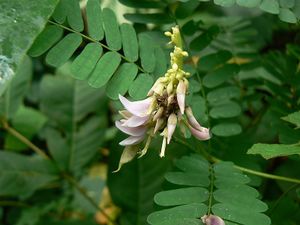Note: This is a project under development. The articles on this wiki are just being initiated and broadly incomplete. You can Help creating new pages.
Difference between revisions of "Inula racemosa hook - Paushkara, Elicampane"
(Created page with "{{stub}} thumb|right|''Abrus precatorius'', '' Gunjaa'' '''Inula racemosa''' is an Asian plant in the daisy family native to the te...") |
(→Photo Gallery) |
||
| Line 61: | Line 61: | ||
==Photo Gallery== | ==Photo Gallery== | ||
<gallery class="left" caption="" widths="140px" heights="140px"> | <gallery class="left" caption="" widths="140px" heights="140px"> | ||
| − | + | File:Inula viscosa01.jpg | |
</gallery> | </gallery> | ||
Revision as of 12:06, 24 September 2018
Inula racemosa is an Asian plant in the daisy family native to the temperate and alpine western Himalayas of Xinjiang, Afghanistan, Kashmir, Nepal, Pakistan.
Contents
- 1 Uses
- 2 Parts Used
- 3 Chemical Composition
- 4 Common names
- 5 Properties
- 6 Habit
- 7 Identification
- 8 List of Ayurvedic medicine in which the herb is used
- 9 Where to get the saplings
- 10 Mode of Propagation
- 11 How to plant/cultivate
- 12 Commonly seen growing in areas
- 13 Photo Gallery
- 14 References
- 15 External Links
Uses
Swelling, Pus formatio, Tuberculoid ulcers, Cerebral impairment disorders, vata impairment disorders, Cardiac asthma, Hiccups, Dyspnoea, Cough, Improves digestion.
Parts Used
Chemical Composition
Common names
| Language | Common name |
|---|---|
| Kannada | Rasnabheda, Padmapatra, Pushkaramoola |
| Hindi | Pohakarmul, Puskarmul |
| Malayalam | Puskaramulam, Puskkaramulam |
| Tamil | puskkaramulam |
| Telugu | Puskaramul |
| Marathi | NA |
| Gujarathi | NA |
| Punjabi | NA |
| Kashmiri | NA |
| Sanskrit | Kasmira, kusthabheda, Padmapatra |
| English | Elicampane |
Properties
Reference: Dravya - Substance, Rasa - Taste, Guna - Qualities, Veerya - Potency, Vipaka - Post-digesion effect, Karma - Pharmacological activity, Prabhava - Therepeutics.
Dravya
Rasa
Guna
Veerya
Vipaka
Karma
Prabhava
Habit
Identification
Leaf
| Kind | Shape | Feature |
|---|---|---|
| Paripinnate | Oblong | Leaf Arrangementis Alternate-spiral |
Flower
| Type | Size | Color and composition | Stamen | More information |
|---|---|---|---|---|
| Unisexual | 2-4cm long | pink | Flowering throughout the year and In terminal and/or axillary pseudoracemes |
Fruit
| Type | Size | Mass | Appearance | Seeds | More information |
|---|---|---|---|---|---|
| oblong pod | Thinly septate, pilose, wrinkled | seeds upto 5 | Fruiting throughout the year |
Other features
List of Ayurvedic medicine in which the herb is used
- Vishatinduka Taila as root juice extract
Where to get the saplings
Mode of Propagation
[[:Category:Index of Plants which can be propagated by |]]
How to plant/cultivate
Commonly seen growing in areas
Orchards, Boundaries of cultivated fields, Along roads and rail tracks, Forest margins.
Photo Gallery
References
External Links
- Pages that are stubs
- Ayurvedic Herbs known to be helpful to treat Swelling
- Ayurvedic Herbs known to be helpful to treat Pus formatio
- Ayurvedic Herbs known to be helpful to treat Tuberculoid ulcers
- Ayurvedic Herbs known to be helpful to treat Cerebral impairment disorders
- Ayurvedic Herbs known to be helpful to treat vata impairment disorders
- Ayurvedic Herbs known to be helpful to treat Cardiac asthma
- Ayurvedic Herbs known to be helpful to treat Hiccups
- Ayurvedic Herbs known to be helpful to treat Dyspnoea
- Ayurvedic Herbs known to be helpful to treat Cough
- Ayurvedic Herbs known to be helpful to treat Improves digestion
- Herbs with Rhizome used in medicine
- Herbs with Roots used in medicine
- Herbs with common name in Kannada
- Herbs with common name in Hindi
- Herbs with common name in Malayalam
- Herbs with common name in Tamil
- Herbs with common name in Telugu
- Herbs with common name in Sanskrit
- Herbs with common name in English
- Habit - Herb
- Index of Plants which can be propagated by
- Herbs that are commonly seen in the region of Orchards
- Herbs that are commonly seen in the region of Boundaries of cultivated fields
- Herbs that are commonly seen in the region of Along roads and rail tracks
- Herbs that are commonly seen in the region of Forest margins
- Herbs

